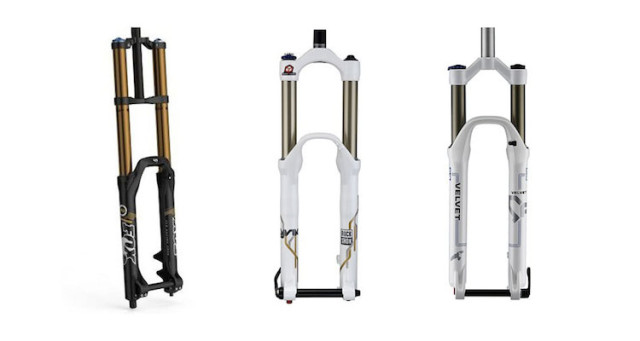The ability to offset the continued impact with the rough terrain on which they are employed is one of the typical characteristics of the bike and is secured by the fork and the rear suspension. Just as there is a wide variety of MTB models with very different characteristics, including the range of forks is very wide.
What are the forks?
The fork is the part of the bike that allows you to secure the bike frame to the front wheel. The forks are mainly used in MTB amortized, but are also used rigid models for specific uses. They are made with two different methods: the telescope, by far the most widespread, and the parallelogram linkage, based on the presence of rods that connect the sheaths the head tube.
The telescopic fork is made from a pipe (head tube, tube) that is inserted in the steering of the bike, from the plate just below the tube (some models have a double plate, especially for very large excursions) and the elongated U-shaped part that goes to contact with the wheel. This part is constituted by two parallel elements of the fork, from the tube to the wheel: It stems and sheaths. The stems are flowing in the sheaths and contain the elements for cushioning. For the realization of the forks are generally used aluminum, magnesium, steel and carbon for the different components, for example, a fork may have sheaths made of magnesium, aluminum and the stems in the steering tube in carbon.
Costs and sizes of forks for MTB.
As mentioned above, the types of forks available on the market today are many, and it is not easy to figure out, which is the best solution for your needs. Prices also vary greatly, ranging from a few $15 for the cheaper models to many hundreds for forks most advanced and efficient. The forks cheaper generally have a cushioning system in the spring, while the higher-end systems have hydraulic cartridges or air.
The forks are distinguishable referring size of the wheels to which they are intended: on the market so we can find forks 26 “, 27.5 ” and 29 “. Another measure that distinguishes between them is that the forks of the excursion ( stroke), ie the measurement of the stem completely uncovered, it is measured in millimeters and can vary a lot. Forks there is a low-end excursions from 35-60 mm and forks for downhill with excursions to 200/300 mm, but are also available forks with adjustable stroke. Simplest terms, we can say that a hike will result in a very large fork ” softer “, with more swings and work out less effective, but more suited to downhill.
Rigid forks.
Mountain bikes can be fitted also rigid forks 26 ” and 29 ” (after a time they were all rigid forks …). The absence of damping is especially suited to routes with compact and homogeneous background, where collisions are minimized, and you can make the most of the pedaling efficiency by eliminating fluctuations tied to the fork. Another advantage of the rigid fork is that in general it is lighter than amortized.
Suspension forks.
The first thing to remember is that the forks … can be ” almost ” stiff. Now the clamping to the handlebar of the fork is a widespread solution and allows to mount a suspension fork that, during output, can be made more similar to a rigid actuating the locking device. Let’s see how you can divide the types of MTB suspension forks into three main categories according to use:
- Cross-count ry/marathon/trail forks – Forks generally low to medium read a range (up to 140 mm), single plate. They are economic models and more advanced models and expensive.
- Forks for freeride / enduro / all-mountain – Forks with a greater excursions of the XC (150/200 mm), in single or double plate, with a weight greater than that of XC. Generally constructive level higher.
- Downhill forks – Very heavy, with extremely high excursions, which are forks in favor ruggedness, durability, hydraulics and precision.
The damping solutions are many and varied, depending on type and manufacturer of the fork. Generally, we have:
- Technique open bath – The springs are immersed in oil contained in sheaths, the same oil used to lubricate and return on investment.
- Technique semi-open bath – In this case you use different oils to lubricate and cushion.
- Technical sealed cartridge – The hydraulic resides in a cartridge.
There are also many other technical changes that depend on the choices of the manufacturer, the use of air spring in oil bath, air from the rooms to the spacers. The user experience or advice of competent dealers and friends will be able to direct us towards the best solution.
Adjust the forks of the bike.
The operating characteristics of the forks can generally be adjusted by means of screws or the like, placed in the bottom of the sheaths or on top of the plate the fork. It is best to proceed gradually in the settings, checking from time to time the effect obtained by experiencing riding the bike. Generally, you can modify the settings of the following settings :
- Sag: the sinking of the static suspension adjusts the fork compresses when you get on the bike. Usually the manufacturer indicates an optimal value of the reference.
- Speed bounce (rebound), which is the speed used by the fork to return to the initial state ( Sag ) after compression.
- Compression rate, ie the rate at which the fork compresses.
What to Choose?
Never before in the choice of a fork for MTB riding experience plays in the important role. The beginner must inevitably rely on the advice of someone who has more experience on the field, given the remarkable diversification of models, materials, construction techniques and intended use.











